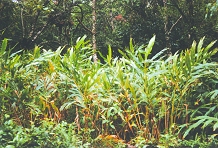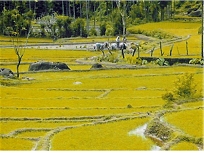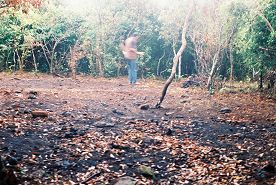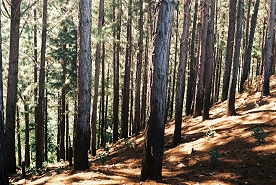|
Cultivation of cardamom under the forest
canopy has become one of the major contributors for the
degradation of forest habitats in Knuckles Mountain Range.
This involves clearing of the shrubs and undergrowth
canopy trees. has become one of the major contributors for the
degradation of forest habitats in Knuckles Mountain Range.
This involves clearing of the shrubs and undergrowth
canopy trees.
Further Cardamom cultivation is done over 3500 feet
elevation in the strict forest reserve, which covers about
2721 hectares. This cultivation has resulted in 21%
heavily degraded sites and 11% open canopy. 88 Barns are
found with in the Knuckles Range, which are used to dry
the Cardamom seeds before they have been send to the
market. The fuel wood for these barns are taken from
illegal felling of trees which is another contributory
factor for degradation of knuckles vegetation. According
to a survey conducted by Socio Environment Foundation
about 5000-6000 hectares in Knuckles Forests have been
damaged as a result of Cardamom cultivation and barns used
to dry the cardamom seeds.
Over grazing which is occurred by large herds of
domestic/feral cattle and buffalo. This can clearly be
seen in Pitawala patana plains in Knuckles range.
 Over use of agricultural chemicals by farmers for paddy
cultivation also a one of the major threats, which can be
seen. An interview conducted with farmers showed that the
over usage of these chemicals occurs due to lack of
awareness. Over use of agricultural chemicals by farmers for paddy
cultivation also a one of the major threats, which can be
seen. An interview conducted with farmers showed that the
over usage of these chemicals occurs due to lack of
awareness.
Further those who visit Knuckles Mountain Range tend to
litter the non-biodegradable materials such as glass
bottles, plastic, and polythene into the environment
carelessly.
Illegal gem mining can be seen in certain areas of
Knuckles Range and this course for degradation of habitats
in these areas.
Hena cultivation and man-induced fires in hena land have
resulted in destruction of forest especially in the buffer
zone of the Knuckles. land have
resulted in destruction of forest especially in the buffer
zone of the Knuckles.
Spread of invasive alien species is also a threat to the
natural ecosystems, native wild plants and animals of
Knuckles Mountain Range. The common invasive alien plants
in the area include lantana (Lantana Camara),
koster’s curse (Clidemia Hirta) and wild
sunflower (Tithonia Diversifolia).
Direct exploitation of Species is also a major problem in
this area. Human activities such as illegal felling of
timber and fuel wood
 species and illegal hunting of animals
can be seen in this area. Further shooting animals or set traps guns and noose traps to kill animals, collection of
fish species from streams for the ornamental fish trade
and collecting of herbaceous plants for ornamental plant
trade are threats to the natural resources in this area.
Over collection of plants and animal species for
commercial purposes and research. /study purposes, course
a major thread, mainly to the endemic and threaded species
in the area. species and illegal hunting of animals
can be seen in this area. Further shooting animals or set traps guns and noose traps to kill animals, collection of
fish species from streams for the ornamental fish trade
and collecting of herbaceous plants for ornamental plant
trade are threats to the natural resources in this area.
Over collection of plants and animal species for
commercial purposes and research. /study purposes, course
a major thread, mainly to the endemic and threaded species
in the area.
|

